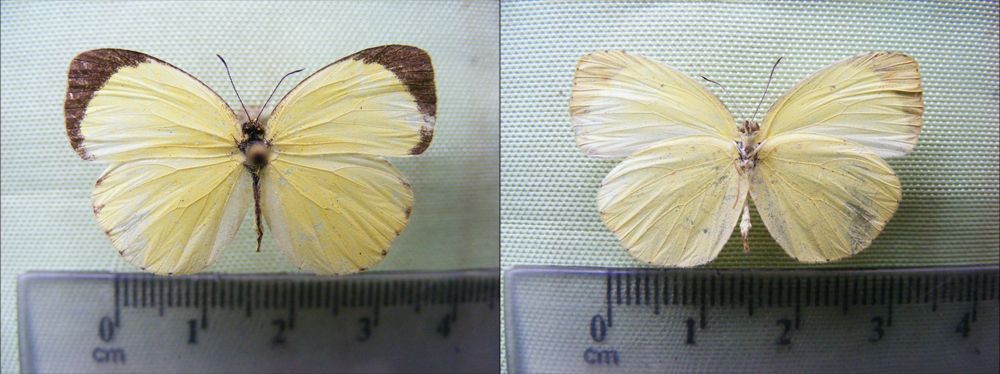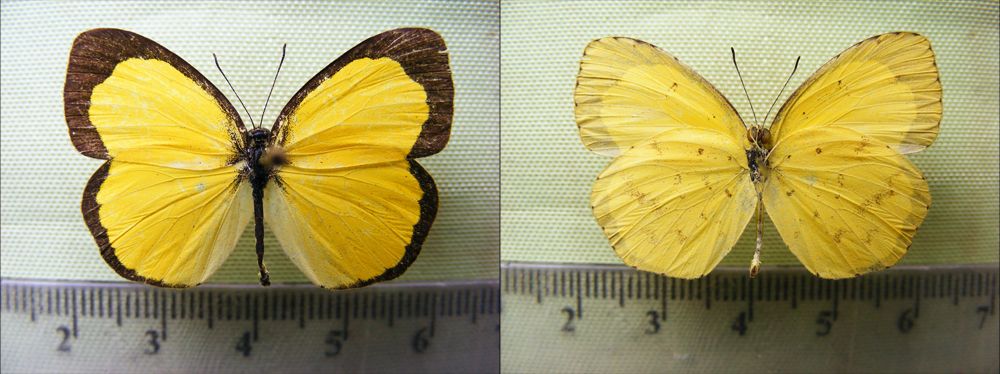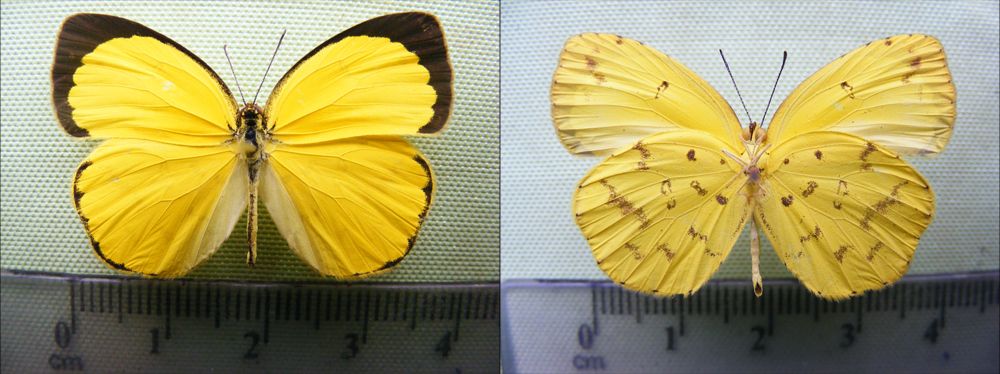Post by cabintom on Aug 24, 2014 10:17:52 GMT -8
So it's been almost a year that I've been trying to get solid IDs on these species... and I'm just as confused as ever. So, I'm not sure if anyone here can truly help me...
From what I gather the problem partly stems from the confusion as to whether or not Eurema desjardinsii is separate from Eurema regularis. Some treat E. regularis as a subspecies of E. desjardinsii and in those cases I'm not sure what happens to E. desjardinsii marshalli... others place E. desjardinsii as purely from Madagascar and E. desjardinsii marshalli as the mainland subspecies, while E. regularis is also found throughout mainland Africa.
Anyways, here are some of the offending specimens:
Females
Specimen 1 (Caught 15/II/2014 near Mbogi, Ituri, DRC)

Specimen 2 (Caught 1/III/2014 near Mbogi, Ituri, DRC)

Males
Specimen 1 (Caught 8/V/14 Bunia, Ituri, DRC)

Specimen 2 (Caught 16/XII/2013 Bunia, Ituri, DRC)

So...
Reviewing Mark C. Williams' www.atbutterflies.com (FILE D – PIERIDAE
SUBFAMILY COLIADINAE), I am led to believe that Male specimen #1 is E. desjardinsii marshalli, but for this species he does not have a reference image of the female. For E. regularis the male reference image that he includes (in my opinion) seems more likely to be a male E. brigitta brigitta (but of course due to the confusion I can't be sure).
I've now also reviewed D'Abrera's "Butterflies of the Afrotropical Region 2nd Ed." and can't take it seriously since, somehow, on the very SAME page he includes the SAME 3 images of specimens to reference both E. regularis and E. floricola.
Thirdly, I've looked at Hubner's revision of the genus Eurema. He treats E. regularis as a subspecies of E. desjardinsii. If that is the case than all 4 specimens would be E. desjardinsii regularis. It would also mean that the 2 females are dry season forms, as is Male specimen #2. However I've caught many specimens of what would be the male wet season form (like specimen #1) on occasions overlapping with these "dry season" specimens.
Google image searches for any combination of these species provide confused and therefore unreliable results.
In the end, the simplest solution would be to follow Hubner... though the wet/dry season forms confuse things (however, my limited 1 year experience in Bunia, DRC has led me to believe the area's butterflies don't generally follow suit with the well defined December to February dry season).
Can anyone clarify this for me??? (or point me in the direction of something/someone that can?)
Thanks so much!
Tom
From what I gather the problem partly stems from the confusion as to whether or not Eurema desjardinsii is separate from Eurema regularis. Some treat E. regularis as a subspecies of E. desjardinsii and in those cases I'm not sure what happens to E. desjardinsii marshalli... others place E. desjardinsii as purely from Madagascar and E. desjardinsii marshalli as the mainland subspecies, while E. regularis is also found throughout mainland Africa.
Anyways, here are some of the offending specimens:
Females
Specimen 1 (Caught 15/II/2014 near Mbogi, Ituri, DRC)

Specimen 2 (Caught 1/III/2014 near Mbogi, Ituri, DRC)

Males
Specimen 1 (Caught 8/V/14 Bunia, Ituri, DRC)

Specimen 2 (Caught 16/XII/2013 Bunia, Ituri, DRC)

So...
Reviewing Mark C. Williams' www.atbutterflies.com (FILE D – PIERIDAE
SUBFAMILY COLIADINAE), I am led to believe that Male specimen #1 is E. desjardinsii marshalli, but for this species he does not have a reference image of the female. For E. regularis the male reference image that he includes (in my opinion) seems more likely to be a male E. brigitta brigitta (but of course due to the confusion I can't be sure).
I've now also reviewed D'Abrera's "Butterflies of the Afrotropical Region 2nd Ed." and can't take it seriously since, somehow, on the very SAME page he includes the SAME 3 images of specimens to reference both E. regularis and E. floricola.
Thirdly, I've looked at Hubner's revision of the genus Eurema. He treats E. regularis as a subspecies of E. desjardinsii. If that is the case than all 4 specimens would be E. desjardinsii regularis. It would also mean that the 2 females are dry season forms, as is Male specimen #2. However I've caught many specimens of what would be the male wet season form (like specimen #1) on occasions overlapping with these "dry season" specimens.
Google image searches for any combination of these species provide confused and therefore unreliable results.
In the end, the simplest solution would be to follow Hubner... though the wet/dry season forms confuse things (however, my limited 1 year experience in Bunia, DRC has led me to believe the area's butterflies don't generally follow suit with the well defined December to February dry season).
Can anyone clarify this for me??? (or point me in the direction of something/someone that can?)
Thanks so much!
Tom

 More likely that no one here has focused on African Pierids... oh well.
More likely that no one here has focused on African Pierids... oh well.